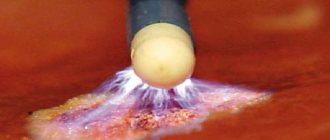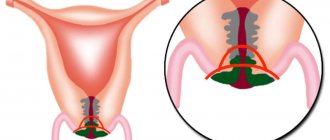For cervical erosion, the doctor prescribes douching in combination with other manipulations, the purpose of which is to relieve unpleasant symptoms and reduce inflammation in this pathology. Vaginal lavage is not used as an independent method in this case. It does not have a direct effect on erosion and therefore, as a rule, does not lead to complete relief of the problem.
Is it possible to douche with soda?
Douching with a baking soda solution can only be done with strict adherence to the frequency of the procedure and dosage. Frequent use of solutions will lead to disruption of the vaginal microflora, causing irritation and drying of the mucous membranes. You should also not douche before gynecological procedures: for example, before colposcopy - due to washing away vaginal discharge, the results of a smear on the flora will be greatly distorted.
If discharge begins, you should first consult a doctor and undergo all the necessary tests to identify the disease and its causes. Do not self-medicate - without tests and medical advice, such procedures can cause serious harm to your health.
If there are contraindications, you cannot douche with soda. The safest would be douching, which is carried out after consultation with a gynecologist. Remember - when treating candidiasis or another infectious disease, you must abstain from sexual activity for the period of treatment. Your partner also needs to be treated, as he may also be infected.
Is douching effective?
Douching for erosion is advisable at an early stage of the disease, as part of complex therapy . For large areas of the lesion, treatment with douching will be unsuccessful.
Frequent vaginal irrigation procedures disrupt the natural microflora, which promotes the proliferation of pathogenic microorganisms. An important condition for douching treatment is avoidance of sexual intercourse during the procedure.
Expert opinion
Dmitrieva Elena Yurievna
Gynecologist-endocrinologist, 40 years of experience
Douching is part of a complex therapy that involves treating pathology in the early stages of development. Professional experience confirms that local treatment of erosion does not guarantee a 100% positive result. The individual resources of the female body, concomitant diseases and general hormonal levels are of great importance. In case of serious damage to the cervical mucosa, doctors do not recommend home treatment, but insist on a cauterization procedure.
Nature of the method and application features
Douching is often used as a method of getting rid of cervical erosion. At the stage when erosion has not acquired significant proportions and the risk of proliferation (transformation into cancer) has not yet arisen, the technique can provide positive results with a very high degree of probability.
Douching is a procedure for washing the vagina using neutral or medicinal solutions that help restore the level of internal microflora, localize tissue areas affected by erosion, with their further atrophy and resuscitation of the uterine epithelium.
The main condition during the procedure is caution and accuracy - you must use only a personal syringe, the tip of which is treated with an antiseptic solution before and after the procedure. It must be inserted into the vagina slowly and carefully so as not to damage the delicate mucous membrane of the vaginal epithelium.
Contraindications and restrictions
Vaginal irrigation is not performed in the following conditions:
- Acute inflammation of the uterus and appendages;
- Severe vaginal dysbiosis;
- Pregnancy;
- The first 6 weeks after childbirth or abortion.
On a note
Douching is not performed during menstruation. It is necessary to wait until the bleeding is completely completed and only then return to therapy.
There are a number of restrictions for douching, which should be familiarized with before starting the procedure in order to avoid undesirable consequences.
Douching is also not recommended for women during menopause. During this period, dryness of the vaginal mucosa is noted against the background of the development of atrophic vaginitis. This problem haunts almost all women after 45 years. Douching for atrophic vaginitis provokes a worsening of the condition and can lead to new problems. In addition, during menopause the risk of developing cervical cancer increases, and such home methods for treating erosion are simply unacceptable.
It is also useful to read: Is cervical erosion dangerous and what consequences to expect if left untreated
To do it or not?
The debate about whether it is worth washing the vagina with various solutions for diseases of the cervix does not subside to this day. Women share with each other various recipes for douching and claim that such a procedure allows you to get rid of erosion once and for all. Calendula and celandine, chamomile and sage, as well as many other medicinal herbs are used. Douching with soda and potassium permanganate solution is very popular. According to reviews, such manipulations eliminate inflammation in the vagina and, therefore, allow you to get rid of erosion that has arisen against the background of a pathological process.
The advantages of douching are known:
- Relatively safe: most medicinal herbs are not capable of causing significant harm;
- Quite effective: the symptoms of inflammation really go away, the woman’s condition improves;
- Can be done at home.
Gynecologists, meanwhile, warn their patients against douching. Until recently, this procedure was actively prescribed to women, but in recent years doctors have revised their tactics. It was found that the harm from douching can be very serious, while the benefits of this procedure are questionable. In this regard, doctors are increasingly less likely to recommend douching to their patients, preferring more modern and effective methods of local treatment.
Before douching, you should consult your doctor to make sure that this therapy is appropriate.
Disadvantages of douching:
- Irrigation of the cervix with solutions disrupts the normal microflora, leads to the development of dysbiosis in the vagina and contributes to the development of inflammatory processes;
- The use of medicinal herbs may cause allergies.
On a note
If itching and burning occurs after douching with herbs, you should rinse the vagina with water and stop using this product.
Technique of the procedure
If a woman is serious about undergoing the procedure, she should consult a gynecologist about this. You need to check with your doctor whether douching can be done for a specific pathology and whether it makes sense for this particular form of erosion. If no contraindications have been identified and certain benefits from the procedure are expected, you should prepare for it.
To douche, you need a syringe and a douching solution. The solution for the procedure can be purchased at a pharmacy or prepared at home. It is recommended to store the finished product for no more than a day.
Scheme:
- Take a comfortable position: lying in the bathtub, over a basin or on the toilet;
- Fill the syringe with a pre-prepared solution;
- Insert the tip of the douche into the vagina;
- Squeeze the syringe so that the solution gradually flows into the vagina and slowly flows out;
- Wash yourself with clean water.
Soda in gynecology
In gynecology, soda is used mainly for douching and washing.
Douching the vagina with soda is used to combat most fungi that cause inflammation. Sodium bicarbonate helps against infections due to the alkaline environment - fungi prefer to multiply in an acidic environment, so increasing the level of alkali in the environment is detrimental to them.
For medicinal purposes, soda douching is used in folk medicine to combat:
- Candida fungi, which are the causative agents of thrush and vulvovaginal candidiasis.
- With ureaplasmosis. Destroys the pathogen - ureaplasma.
- With changes in microflora as a result of menopause. During periods of hormonal changes, women often suffer from vaginal dysbiosis (dysbacteriosis). Soda solutions help cope with pathogenic microflora and eliminate the problem.
The well-known “soda expert”, Professor Neumyvakin, recommends the use of soda baths, which are useful for preventing infections and are suitable as a means for intimate hygiene.
The benefits and harms of the procedure
Using baking soda for thrush can be both beneficial and harmful. It is possible to reduce the risk of adverse reactions if medical procedures are carried out under the supervision of gynecologists.
Advantages
The technique has the following advantages:
- availability of raw materials;
- the solution washes away the pathogen cells;
- the acidic environment in the vagina becomes alkaline, which inhibits the active reproduction of pathogenic microflora.
Flaws
The disadvantages of the technique include:
- many contraindications;
- Soda should not be used during pregnancy or after childbirth/abortion;
- the wrong concentration can cause a burn on the mucous membranes;
- long course of therapy.
How often can you douche with soda?
The frequency of the procedure depends on the form and course of the disease. The duration of soda douching is also determined individually, but experts recommend not to carry out treatment for more than 14 days, with the exception of uterine fibroids - in this case, the course of douching can last up to six months.
The procedure is not performed on menstruation days. Also, experts do not recommend douching 2 days before the start of menstruation and 2 days after the end of menstruation.
Women using soda solutions for conception should douche only from the 10th to 18th day of the menstrual cycle, when the formation of the egg occurs. The procedure is carried out 1-1.5 hours before sexual intercourse.
What can't be used?
For douching, you should not use potassium permanganate, chlorhexidine, or urine . An important condition is compliance with the dosage; the douching procedure is not recommended for more than 3 weeks.
CAREFULLY!
Prolonged irrigation of the vagina washes away natural lubrication, which leads to dryness and irritation of the tissues.
Frequent procedures reduce the protective properties of the mucous membrane and can cause the penetration of pathogenic microbes.
The asymptomatic development of erosion complicates early diagnosis. To prevent a dangerous disease, it is important to undergo a gynecological examination twice a year. Detection of erosion in the initial stage makes it possible to cure the disease using conservative methods.
How to douche with soda correctly?
To make treatment with soda successful and without complications, follow a few simple rules:
- Do not use concentrated solution. To prepare it correctly, there are optimal proportions that are not harmful to health - 0.5 (1/2) tsp. baking soda per 1 liter of water.
- Before diluting the soda powder, extinguish it with a small amount of boiling water.
- For the procedure, you must use a syringe, which is pre-disinfected with alcohol or chlorhexidine.
- During treatment, avoid visiting the swimming pool, bathhouse and sauna. It is also better to refrain from taking baths.
- Do not douche together with the use of suppositories, ointments or antibiotics.
- Try to wear loose underwear made from natural fabrics. Avoid synthetic lace and thongs - too tight synthetic underwear interferes with air circulation and creates a breeding ground for the development of bacteria.
The douching procedure is carried out as follows:
- Fill a syringe with soda solution. Take a horizontal position and slightly lift your pelvis. Some women recommend douching in the bathtub with their legs over the sides.
- Insert the tip of the douche into the vagina. You need to press it lightly so that the stream flows smoothly.
Also, to restore healthy microflora, many women use a solution of hydrogen peroxide. The solution is prepared according to the following recipe: 1 liter. water should be diluted with 2 tbsp. l. peroxide.
Using soda solution
A fairly popular way to treat erosive manifestations in the cervix is douching with soda for erosion. The recipe for this product is quite simple - a teaspoon of soda is dissolved in 500 ml of warm water, and the douching procedure is performed for about 10-15 minutes.
The course of the treatment procedure lasts about 2 weeks, and you must adhere to medical recommendations and carefully monitor your own well-being.
If a woman systematically experiences a feeling of discomfort and burning after the procedure, she should immediately abandon the procedure and consult a doctor. Soda is a fairly aggressive substance, and, in addition to its antiseptic and healing properties, it can become an additional irritant and provoke further progress of erosive pathology.
Alternative methods of douching
In addition to soda, douching with herbs, which have healing and restorative properties, is quite actively used, allowing the treatment process to be combined with the rehabilitation of the female body.
In particular, plants such as:
- bergenia thick-leaved;
- calendula;
- eucalyptus;
- mistletoe;
- evasive peony;
- true bedstraw;
- chamomile.
Most of these herbs are used in the form of tinctures and decoctions, which are quite easy to prepare at home.
A particularly popular and effective remedy for erosive lesions in the uterine cervix is chamomile. Its decoction has a healing antibacterial and regenerating effect.
The decoction is prepared as follows: pour 1 tablespoon of dried flowers into 500 ml of water, place on medium heat and wait until the decoction boils. The decoction should steep for 15-20 minutes. When the liquid has cooled to a comfortable temperature level, it can be used for douching.
When you need to decide what and how to douche for cervical erosion, you first need to consult with your doctor.
How to douche for cervical erosion
Soda
The most popular means for carrying out the procedure. A teaspoon of soda is dissolved in 0.5 liters of water. The finished solution should be warm. It is recommended to douche for no more than 10 minutes.
Soda has an antiseptic and wound-healing effect, eliminates inflammation and can be used for some cervicitis caused by opportunistic flora. It is not recommended to carry out the procedure for more than 10 minutes or more often than every other day - the risk of damaging the mucous membrane with a fairly aggressive solution is too high.
Potassium permanganate solution (potassium permanganate)
For douching, use a 0.1% solution of potassium permanganate - very weak, slightly pink. This solution dries out the vaginal mucosa, but is capable of destroying not only pathogens, but also normal microflora. It is quite difficult to restore its balance after this aggressive remedy.
In addition, if the rules for preparing the solution are not followed, you can get a burn to the mucous membranes. Gynecologists do not recommend this method for cervical erosion as it is quite dangerous for women’s health.
Hydrogen peroxide
To prepare the drug, you need to take a pharmacy 3% solution of hydrogen peroxide and dilute it with warm water (1 part peroxide to 3 parts water). The resulting solution has pronounced disinfectant properties, but it is not recommended to use it often. The duration of the course of therapy should not exceed 5 procedures every other day.
Attention It is forbidden to use an undiluted 3% hydrogen peroxide solution for douching - you can get burned!
Chlorhexidine
For convenience, you can purchase a ready-made douching solution with a special nozzle. You cannot heat the solution - this will change its antiseptic properties. For the procedure, 10 ml of chlorhexidine is enough. The scheme of its use does not differ from that described above.
During therapy with this drug, many women experience itching and burning in the vagina. If discomfort persists, you should rinse thoroughly with plain water and subsequently stop using chlorhexidine.
It is also useful to read: Modern methods of removing cervical erosion
ASD-2
The drug was created for the treatment of animals and is used in veterinary medicine. Gynecologists do not prescribe this remedy to their patients. It is believed that ASD-2 eliminates inflammation, including erosion, and is especially effective against trichomoniasis and chlamydia. Convincing data on this has not been obtained, but the drug is popular among supporters of home treatment.
In what cases can douching be used?
Vaginal irrigation for erosion is prescribed as an adjuvant. It is important to understand: no solutions can save a woman from such a pathology. The only thing that can be achieved with this procedure is to relieve inflammation and thereby eliminate the probable cause of some forms of erosion.
Indications for douching:
- True erosion against the background of an inflammatory process;
- Cervicitis and vaginitis with ectopia, dysplasia and other pathologies of the cervix (as the initial stage of therapy).
Thus, the doctor first eliminates inflammation in the vagina and cervix using various local medications and only then decides on further treatment. In this case, douching can replace the use of suppositories and vaginal tablets. During therapy, true erosion, a defect in the mucous membrane that occurs due to the active proliferation of pathogenic microorganisms, may go away. Other forms of the disease usually require different treatment.
Important
Douching with soda, herbal decoctions, and chlorhexidine will help cope with inflammation caused by opportunistic flora (nonspecific colpitis and cervicitis). For HPV, chlamydial and mycoplasma infections, such drugs are not effective.
Herbs for douching for cervical pathology
Calendula
For 500 ml of water, 3-4 tbsp is enough. l. calendula flowers. The resulting broth should be cooled. It is recommended to douche daily at night. Calendula has a wound-healing and antiseptic effect, eliminates inflammation and reduces itching with concomitant cervicitis and vaginitis.
Decoctions of many herbs are used for douching, but each of them has specific properties and can have different effects on certain pathologies of the cervix.
Celandine
Take 1 tbsp per glass of water. l. dry grass. It is believed that celandine has an antitumor effect, and that is why it is actively used for cervical erosion. Unfortunately, this herb does not help cure cancer or even reduce the risk of cancer. Celandine is also not effective against HPV infection. All this solution does is relieve inflammation and eliminate the unpleasant symptoms of concomitant cervicitis.
Chamomile officinalis
Take 1 tbsp per glass of water. l. chamomile flowers. The plant is known for its wound healing and anti-inflammatory properties. Chamomile is considered one of the mildest and safest drugs recommended for the treatment of erosion. It quite rarely causes allergic reactions, which makes it deservedly popular among women.
Sage
The method of preparing a solution for douching does not differ from that for other herbs. Sage has a calming effect, helps fight pathogens, eliminates burning and itching associated with cervicitis.
Red brush
For douching, take 1 tbsp. l. dry herbs to 1 glass of water. This remedy is known for its beneficial effects on women's health. It is believed that the red brush not only eliminates inflammation during erosion, but also normalizes the microflora and also restores hormonal levels. There have been no comprehensive studies on this issue, so doctors are not very active in prescribing this herb for such procedures.
According to reviews, the red brush helps many women get rid of erosion and other gynecological diseases, but it is quite difficult to verify these claims. The absence of symptoms does not mean a complete cure, and only after examination by a doctor can any conclusions be drawn. Unfortunately, women who use traditional methods of therapy do not always turn to specialists, so it is quite difficult to assess the real effectiveness of the red brush for erosion.
After cauterization of erosion, douching is not recommended for up to 6 weeks, so as not to disrupt the regeneration process.
In gynecology, douching after cauterization and other destructive methods of therapy is not practiced. After all the manipulations, the mucous membrane of the cervix becomes very sensitive to any irritants. For 4-6 weeks after cauterization, it is not recommended to use tampons, be sexually active, or take various smears and tests. Moreover, you should not douche - the risk of damaging the mucous membrane and slowing down the natural healing processes is too high.
The likelihood of dysbiosis and imbalance of the vaginal microflora is another reason why douching is not prescribed after cauterization. In the first month, active healing of the cervical mucosa occurs, as well as the restoration of the number of beneficial lactobacilli. Douching washes out beneficial flora from the vagina, creating conditions for the penetration of pathogenic microorganisms. All this threatens the development of cervicitis and colpitis and can subsequently cause relapse of erosion.
The question of whether it is worth douching for cervical erosion remains open. Gynecologists do not advise once again interfering with the established system of vaginal microflora and using various solutions for its irrigation. Normally, cleansing occurs spontaneously, and there is no need to administer additional medications. For the treatment of inflammatory processes, it is much more effective to use suppositories and vaginal tablets, which deliver the active substance directly to the site of inflammation and work specifically against specific microorganisms. If you have any doubts, it would be a good idea to consult your doctor.
Useful video about douching: advice from a gynecologist on how to safely carry out the procedure
How does baking soda promote pregnancy?
How can baking soda help speed up conception? It helps create a vaginal environment that is considered most favorable for pregnancy. Normally, the vaginal microflora has an acidic pH. This is a kind of protective barrier for the female organs. In such an environment, pathogenic microorganisms cannot develop. Microflora with high acidity reduces the risk of developing various female diseases.
For successful conception, neutralization of the acidic environment is required. Otherwise, sperm may die without reaching their goal. Nature intended it this way that during ovulation the pH drops to an alkaline level. These days, the female body regards reproductive function as the main one and reduces protection. But if acidity is greatly increased during the ovulatory period, then sperm cannot reach the egg and die halfway. Because of this, pregnancy may not occur, despite all attempts and the absence of diseases in partners.
Treatment with soda solution
The main causes of thrush are improper functioning of metabolic processes in the body, weak immunity, the result of treatment with antibiotics, as well as the process of inflammation of the genitourinary system.
Antibacterial medications containing an alkaline substance that can remove it from the body will help get rid of the main yeast-like fungus of the genus Candadida. They also cleanse the microflora and vaginal walls.
Is it possible to treat thrush with a soda solution? It is possible, but this should not be the main type of treatment, but an auxiliary one. As a rule, it is used for prevention.
Many women replace soap with soda. Why?
- Soda has high antibacterial properties, perfectly relieves itching and burning, removes white discharge and irritation.
- Baking soda, unlike soap, does not dry out the skin and vaginal microflora.
- Due to the fact that soda contains a large amount of alkali, pregnancy may occur after douching. Therefore, if you are planning a pregnancy, then you can douche with soda for thrush at a certain time after menstruation, this way the acidity in the vagina decreases and sperm do not die.
- Unlike traditional herbs, soda helps remove only harmful microorganisms, while beneficial ones remain untouched.
To get rid of external symptoms, it is enough to douche with an aqueous solution of soda (baking soda) several times a day, preferably after a shower. If you feel pain and have internal irritation, it is recommended to alternate baking soda with medications. It will have a greater effect if you first douche with soda and then use antibacterial gel (only as prescribed by a doctor).










